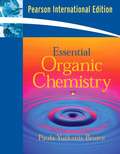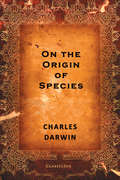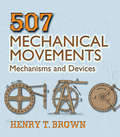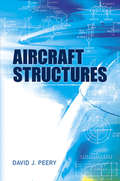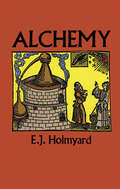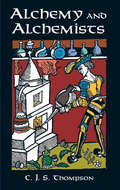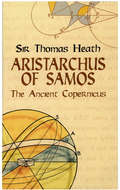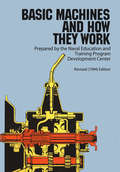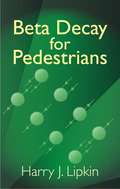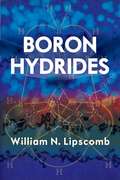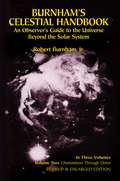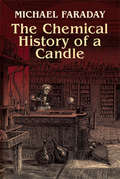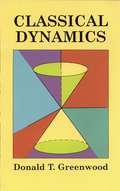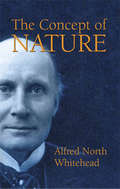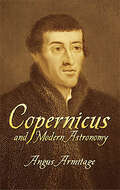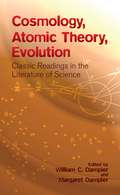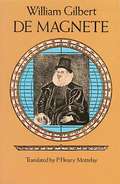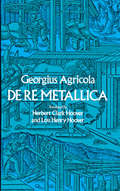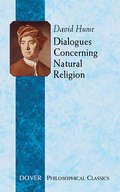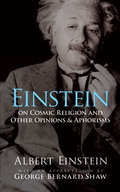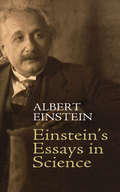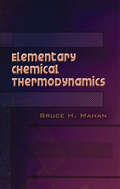- Table View
- List View
General Chemistry
by Bruce Averill Patricia EldredgeThe overall goal of the authors with General Chemistry: Principles, Patterns, and Applications was to produce a text that introduces the students to the relevance and excitement of chemistry. Although much of first-year chemistry is taught as a service course, Bruce and Patricia feel there is no reason that the intrinsic excitement and potential of chemistry cannot be the focal point of the text and the course. So, they emphasize the positive aspects of chemistry and its relationship to students’ lives, which requires bringing in applications early and often. In addition, the authors feel that many first year chemistry students have an enthusiasm for biologically and medically relevant topics, so they use an integrated approach in their text that includes explicit discussions of biological and environmental applications of chemistry. Topics relevant to materials science are also introduced to meet the more specific needs of engineering students.
General Chemistry
by Bruce Averill Patricia EldredgeThe overall goal of the authors with General Chemistry: Principles, Patterns, and Applications was to produce a text that introduces the students to the relevance and excitement of chemistry. Although much of first-year chemistry is taught as a service course, Bruce and Patricia feel there is no reason that the intrinsic excitement and potential of chemistry cannot be the focal point of the text and the course. So, they emphasize the positive aspects of chemistry and its relationship to students' lives, which requires bringing in applications early and often. In addition, the authors feel that many first year chemistry students have an enthusiasm for biologically and medically relevant topics, so they use an integrated approach in their text that includes explicit discussions of biological and environmental applications of chemistry. Topics relevant to materials science are also introduced to meet the more specific needs of engineering students.
Introductory Chemistry
by David W. BallDavid W. Ball of Cleveland State University brings his new survey of general chemistry text, Introductory Chemistry, to the market with a fresh theme that will be sure to hold student interest: "Chemistry is Everywhere." Introductory Chemistry is intended for a one-semester introductory or preparatory chemistry course.
Introductory Statistics
by Douglas S. Shafer Zhiyi ZhangIn many introductory level courses today, teachers are challenged with the task of fitting in all of the core concepts of the course in a limited period of time. The Introductory Statistics teacher is no stranger to this challenge. To add to the difficulty, many textbooks contain an overabundance of material, which not only results in the need for further streamlining, but also in intimidated students. Shafer and Zhang wrote Introductory Statistics by using their vast teaching experience to present a complete look at introductory statistics topics while keeping in mind a realistic expectation with respect to course duration and students' maturity level. Over time the core content of this course has developed into a well-defined body of material that is substantial for a one-semester course. Shafer and Zhang believe that the students in this course are best served by a focus on that core material and not by an exposure to a plethora of peripheral topics. Therefore in writing Introduction to Statistics they have sought to present only the core concepts and use a wide-ranging set of exercises for each concept to drive comprehension. As a result Introduction to Statistics is a smaller and less intimidating textbook that trades some extended and unnecessary topics for a better-focused presentation of the central material.
On the Origin of Species
by Charles DarwinIn On the Origin of Species, naturalist Charles Darwin examines the role of natural selection in the evolution of plant and animal species. Revolutionary at the time of its publication in 1859, On the Origin of Species and Darwin's theory of natural selection served as one of the foundations or modern theories of evolution.Be it mystery, romance, drama, comedy, politics, or history, great literature stands the test of time. ClassicJoe proudly brings literary classics to today's digital readers, connecting those who love to read with authors whose work continues to get people talking. Look for other fiction and non-fiction classics from ClassicJoe.
507 Mechanical Movements: Mechanisms and Devices
by Henry T. BrownEpicyclic trains, oblique rollers, trip hammers, and lazy-tongs are among the ingenious mechanisms defined and illustrated in this intriguing collection. Spanning the first century of the Industrial Revolution, this 1868 compilation features simplified, concise illustrations of the mechanisms used in hydraulics, steam engines, pneumatics, presses, horologes, and scores of other machines.The movements of each of the 507 mechanisms are depicted in drawings on the left-hand page, and the facing page presents a brief description of the item's use and operation. Ranging from simple to intricately complex, the mechanisms offer a fascinating view of the variety of small components that constitute complex machinery. A detailed index provides easy reference to specific mechanisms.Inventors, tinkerers, and anyone with an interest in the history of invention and technology will find this volume a treasury of information and inspiration.
Aircraft Structures (Dover Books on Aeronautical Engineering)
by David J. PeeryStill relevant decades after its 1950 publication, this legendary reference text on aircraft stress analysis is considered the best book on the subject. It emphasizes basic structural theory, which remains unchanged with the development of new materials and construction methods, and the application of the elementary principles of mechanics to the analysis of aircraft structures. Suitable for undergraduate students, this volume covers equilibrium of forces, space structures, inertia forces and load factors, shear and bending stresses, and beams with unsymmetrical cross sections. Additional topics include spanwise air-load distribution, external loads on the airplane, joints and fittings, deflections of structures, and special methods of analysis. Topics involving a knowledge of aerodynamics appear in final chapters, allowing students to study the prerequisite aerodynamics topics in concurrent courses.
Alchemy (Dover Books on Engineering)
by E. J. HolmyardAlchemy is thought to have originated over 2000 years ago in Hellenic Egypt, the result of three converging streams: Greek philosophy, Egyptian technology and the mysticism of Middle Eastern religions. Its heyday was from about 800 A.D. to the middle of the seventeenth century, and its practitioners ranged from kings, popes, and emperors to minor clergy, parish clerks, smiths, dyers, and tinkers. Even such accomplished men as Roger Bacon, Thomas Aquinas, Sir Thomas Browne and Isaac Newton took an interest in alchemical matters.In its search for the "Philosopher's Stone" that would transmute base metals into silver and gold, alchemy took on many philosophical, religious and mystical overtones. These and many other facets of alchemy are explored with enormous insight and erudition in this classic work. E. J. Holmyard, a noted scholar in the field, begins with the alchemists of ancient Greece and China and goes on to discuss alchemical apparatus, Islamic and early Western alchemy; signs, symbols, and secret terms; Paracelsus; English, Scottish and French alchemists; Helvetius, Price, and Semler, and much more.Ranging over two millennia of alchemical history, Mr. Holmyard shows how, like astrology and witchcraft, alchemy was an integral part of the pre-scientific moral order, arousing the cupidity of princes, the blind fear of mobs and the intellectual curiosity of learned men. Eventually, however, with the advent and ascension of the scientific method, the hopes and ideas of the alchemists faded to the status of "pseudo-science." That transformation, as well as alchemy's undeniable role as a precursor of modern chemistry, are brilliantly illuminated in this book. Students of alchemy, chemistry, the history of science, and the occult, plus anyone interested in the origin and evolution of one of mankind's most enduring and influential myths, will want to have a copy of this masterly study.
Alchemy and Alchemists
by C. J. ThompsonAlchemy, whose beginnings — possibly in Egypt, Babylon, India, or China — are ancient and obscure, remained undocumented until about 2500 BC. Although it may have originated with metallurgy, the practice rapidly developed an association with magic, pharmacy, and astrology. In this richly illustrated and amply researched study, a noted expert traces the long history of alchemy, from its murky start to modern times. Hermes Trismegistus and other famous alchemists appear here, along with discussions of the craft's associations with chicanery (as memorably portrayed in Ben Jonson's 1610 comedy, The Alchemist), and its role in the secret society of Rosicrucians. Additional topics include the alchemist's laboratory and equipment, alchemical symbols and secret alphabets, noteworthy manuscripts, the influence of astrology, and more. Although regarded today as a pseudoscience, alchemy gave rise to scientific chemistry. This volume illustrates the ways in which efforts to transmute metals — such as the search for the ever-elusive philosopher's stone — stimulated experimentation with hitherto untried substances, leading to improved knowledge of the materials vital to applied chemistry. Anyone intrigued by the origins and practices of this age-old and still-mysterious discipline, as well as those interested in the history of chemistry, will appreciate this concise, authoritative study.
Aristarchus of Samos: The Ancient Copernicus
by Thomas Heath"A most welcome addition to the literature of astronomical history." -- Nature"A most important contribution to the early history of Greek thought and a notable monument of English scholarship." -- Journal of Hellenic StudiesThis classic work traces Aristarchus of Samos's anticipation by two millennia of Copernicus's revolutionary theory of the orbital motion of the earth. Heath's history of astronomy ranges from Homer and Hesiod to Aristarchus and includes quotes from numerous thinkers, compilers, and scholasticists from Thales and Anaximander through Pythagoras, Plato, Aristotle, and Heraclides. 34 figures.
Basic Machines and How They Work
by Naval EducationThis revised edition of an extremely clear Navy training manual leaves nothing to be desired in its presentation. Thorough in its coverage of basic theory, from the lever and inclined plane to internal combustion engines and power trains, it requires nothing more than an understanding of the most elementary mathematics. Beginning with the simplest of machines — the lever — the text proceeds to discussions of the block and tackle (pulleys and hoists), wheel and axle, the inclined plane and the wedge, the screw, and different types of gears (simple, spur, bevel, herringbone, spiral, worm, etc.). A chapter on the concept of work discusses the measurement of work, friction, and efficiency; this is followed by investigations of power, force, and pressure, with explanations of the uses of scales, balances, gauges, and barometers. The fundamentals of hydrostatic and hydraulic machines (such as the hydraulic braking system and the hydraulic press) are discussed in detail. The remaining chapters cover machine elements (bearings and springs), basic mechanisms (gear differential, couplings, cams, clutches), the internal combustion engine and power trains (including explanations of various transmission systems — synchromesh, auxiliary, etc.). Every concept is clearly defined, and discussions always build easily from elementary theory to specific applications familiar to anyone with the slightest interest in mechanics. Important concepts, machine components, and techniques are clearly illustrated in more than 200 diagrams, drawings, and cross-sections that reveal inner workings — all of these help to clarify even further an already clear and well-organized presentation. Although it was originally designed for use in U.S. Naval Training Schools, this book can be used to great advantage as a basic text in mechanical engineering in standard technical schools, and it will be immensely valuable even to lay readers who desire a basic knowledge of mechanics.
Beta Decay for Pedestrians
by Harry J. LipkinThe "pedestrian approach" was developed to describe some essentially simple experimental results and their theoretical implications in plain language. In this graduate-level text, Harry J. Lipkin presents simply, but without oversimplification, the aspects of beta decay that can be understood without reference to the formal theory; that is, the reactions that follow directly from conservation laws and elementary quantum mechanics.The pedestrian treatment is neither a substitute for a complete treatment nor a watered-down version. Its derivation of results obtainable without the formal theory makes these results more understandable and less mysterious to those who have neither the time nor the inclination to master the details of the theory. On the other hand, those already acquainted with the formal theory will find in the pedestrian treatment a clear distinction between results dependent on the specific assumptions underlying the formal theory and those independent of these assumptions, which follow from simple general principles. Since peculiar experimental results are an ever-present possibility, it is always useful to have a simple method of evaluating challenges to theoretical assumptions or approximations.
Boron Hydrides (Dover Books on Chemistry)
by William N. LipscombIn this classic monograph, Nobel Prize–winning chemist William N. Lipscomb elucidates his area of expertise: the general structural principles and reactions of boron hydrides and related compounds. Lipscomb's work appeared only a decade after the structures of boron hydrides were first elucidated and their chemistry formulated into a widely applicable framework. His observations led to a major reconsideration of how atoms bond to form stable molecules.A concise treatment of the many separate parts of the structural theory and its relation to chemistry, this volume begins with an overview of boron hydrides and related structures, progressing to three-center bonds and their applications, molecular orbitals, nuclear magnetic resonance studies of boron hydrides and related compounds, and reactions of the boron hydrides. More than 120 diagrams and figures illustrate a variety of structures.
Burnham's Celestial Handbook: An Observer's Guide to the Universe Beyond the Solar System (Chameleon Through Orion #Volume Two)
by Robert Burnham Jr.Chamaeleon Through OrionWhile there are many books on stars, there is only one Celestial Handbook. Now completely revised through 1977, this unique and necessary reference is available once again to guide amateur and advanced astronomers in their knowledge and enjoyment of the stars. After an extensive introduction in Volume I, which gives the beginner enough information to follow about 80 percent of the body of the material, the author gives comprehensive coverage to the thousands of celestial objects outside our solar system that are within the range of telescopes in the two- to twelve-inch range. The objects are grouped according to the constellations in which they appear. Each constellation is divided into four subject sections: list of double and multiple stars; list of variable stars; list of star clusters, nebulae, and galaxies; and descriptive notes. For each object the author gives names, celestial coordinates, classification, and full physical description. These, together with a star atlas, will help you find and identify almost every object of interest. But the joy of the book is the descriptive notes that follow. They cover history, unusual movements or appearances, and currently accepted explanations of such visible phenomena as white dwarfs, novae and supernovae, cepheids, mira-type variables, dark nebulae, gaseous nebulae, eclipsing binary stars, the large Magellanic cloud, the evolution of a star cluster, and hundreds of other topics, many of which are difficult to find in one place. Hundreds of charts and other visual aids are included to help in identification. Over 300 photographs capture the objects and, in themselves, are works of beauty that reflect the enthusiasm that star gazers have for their subject.
The Chemical History of a Candle
by Michael FaradayOne of the greatest experimental scientists of all time, Michael Faraday (1791–1867) developed the first electric motor, electric generator, and dynamo — essentially creating the science of electrochemistry. This book, the result of six lectures he delivered to young students at London’s Royal Institution, concerns another form of energy — candlelight.Faraday titled the lectures "The Chemical History of a Candle," choosing the subject because, as he explained, "There is not a law under which any part of this universe is governed which does not come into play and is not touched upon [during the time a candle burns]."That statement is the foundation for a book that describes, with great clarity, the components, function and weight of the atmosphere; the function of a candle wick; capillary attraction; the carbon content in oxygen and living bodies; the production of carbon dioxide from coal gas and sugar; the properties of carbonic acid; respiration and its analogy to the burning of a candle; and much more. There is also a chapter comprising Faraday's "Lecture on Platinum."A useful classroom teaching tool, this classic text will also appeal to a wide audience interested in scientific inquiry.
Classical Dynamics (Dover Books On Physics Series)
by Donald T. GreenwoodSince Lagrange laid the foundation of analytical dynamics some two centuries ago, the discipline has continued to evolve and develop, embracing the theories of Hamilton and Jacobi, Einstein's relativity theory and advanced theories of classical mechanics.This text proposes to give graduate students in science and engineering a strong background in the more abstract and intellectually satisfying areas of dynamical theory. It is assumed that students are familiar with the principles of vectorial mechanics and have some facility in the use of this theory for analysis of systems of particles and for rigid-body rotation in two and three dimensions.After a concise review of basic concepts in Chapter 1, the author proceeds from Lagrange's and Hamilton's equations to Hamilton-Jacobi theory and canonical transformations. Topics include d'Alembert's principle and the idea of virtual work, the derivation of Langrange's equation of motion, special applications of Lagrange's equations, Hamilton's equations, the Hamilton-Jacobi theory, canonical transformations and an introduction to relativity.Problems included at the end of each chapter will help the student greatly in solidifying his grasp of the principal concepts of classical dynamics. An annotated bibliography at the end of each chapter, a detailed table of contents and index, and selected end-of-chapter answers complete this highly instructive text.
The Concept of Nature: The Tarner Lectures Delivered In Trinity College, November 1919 (classic Reprint)
by Alfred North WhiteheadIn addition to his brilliant achievements in theoretical mathematics, Alfred North Whitehead exercised an extensive knowledge of philosophy and literature that informs and elevates all of his works. This book represents one of his most significant achievements in the field of natural philosophy. The Concept of Nature originated with Whitehead's Tarner Lectures, and it offers undergraduate students and other readers an absorbing exploration of the fundamental problems of substance, space, and time.Whitehead's discussions are highlighted by a criticism of Einstein's method of interpreting results, and by his alternative development of the celebrated theory of the four-dimensional space-time manifold.
Copernicus and Modern Astronomy
by Angus ArmitageMasterly and authoritative, this book by the foremost scholar on the 16th-century astronomer provides lucid accounts of the development and progress of the Copernican theory as well as a fascinating portrait of the man who clarified the basis for modern cosmology. 41 figures. 6 halftones.
Cosmology, Atomic Theory, Evolution: Classic Readings in the Literature of Science (General Science)
by William Dampier Margaret DampierFrom the biblical book of Genesis to Henri Bergson's Creative Evolution, these extracts from world literature illustrate the development of scientific thought across millennia. Starting with speculations by the ancient Greeks on the structure of the universe, selections on cosmogony include works by Copernicus, Galileo, Newton, Laplace, Foucault, and Einstein. Theories and reports on experimental results concerning the nature of matter range from Paracelsus' writings on alchemy to Faraday's work with electrochemistry and Sir Ernest Rutherford's studies of radioactivity and the structure of the atom. The final section on evolutionary theory begins with Aristotle and Pliny and features landmark works by the giants in the field, among them, Linnaeus, Lamarck, Lyell, Malthus, Darwin, and Mendel. 36 figures. 7 tables.
De Magnete
by William GilbertMuch of modern science is based upon the theories and discoveries of William Gilbert, the brilliant English physician and physicist who was the first great experimental scientist. Gilbert was the first to use the word "electricity," to recognize mass as distinct from weight, to discover the effect of heat upon magnetic bodies, to differentiate clearly between static electricity and magnetism, and to explain phenomena of terrestrial magnetism in terms of the earth as a giant magnet.In 1600 he published De Magnete in Latin. As lively and entertaining as it was scientifically scrupulous, it summarized everything that had previously been known about electricity and magnetism, founded a new science and earned Gilbert the title of "the father of modern electricity." In it Gilbert explores magnetism and electricity, lodestones, phenomena of magnetism, direction of the earth's magnetic lines of force, variation in the compass, dip, the concept of the earth as a giant magnet, and much else.This Dover edition is a complete, unabridged reprinting of the definitive English translation of De Magnete prepared by Dr. P. Fleury Mottelay. Dr. Mottelay has added a number of footnotes that explain points that might be obscure to today's readers, who will find in this historically important text invaluable insights into the origins of modern science and physics. Translation by P. F. Mottelay. Biographical introduction. 90 illustrations.
De Re Metallica: De Re Metallica. Libri Xii. . . (Dover Earth Science)
by Georgius AgricolaOriginally published in 1556, Agricola's De ReM etallica was the first book on mining to be based on field research and observation — what today would be called the "scientific approach." It was therefore the first book to offer detailed technical drawings to illustrate the various specialized techniques of the many branches of mining, and the first to provide a realistic history of mining from antiquity to the mid-sixteenth century. For almost 200 years, Agricola remained the only authoritative work in this area and by modern times it had become one of the most highly respected scientific classics of all time. A book more often referred to in literature on mining and metallurgy than any other, its Latin text prevented it from being as widely used as it might have been. <p><p> In 1912, the book was translated by former President Herbert Clark Hoover and his wife. Printed in a limited edition, the work was quickly bought up by book collectors, historians, and medievalists, who had found that there was much to be learned from its pages. The book contains an unprecedented wealth of material on alluvial mining, alchemy, silver refining, smelting, surveying, timbering, nitric acid making, and hundreds of other phases of the medieval art of metallurgy. The text even covers the legal aspects of mining the use of boundary stones, forfeitures of titles, safety requirements of tunnel building in the 1500s, and so on. <p> But the plates, perhaps more than anything else, have insured Agricola's continued importance. Brilliantly executed drawings, richly detailed, reveal a whole medieval world of machinery, industrial technique, tools, even costume and architecture. All 289 of the original woodcuts are reproduced in this reprint of the 1912 edition, offering students of the period, commercial artists, engineers, metallurgists, and even curious general readers an unforgettable picture of the first age of technology.
Dialogues Concerning Natural Religion
by David HumeHow can we know that God exists? Is it possible to find proof of religion's most significant issues? Can we presume that the orderliness of the universe offers evidence of a purposeful creator? David Hume's Dialogues Concerning Natural Religion explores these perennial questions in a thought-provoking and highly readable style.This classic examines its controversial subject in the well-known manner of the Platonic dialogues. Hume's characters discuss God's existence, his divinity and attributes, and the reasons behind his creation of the world. In clear, evocative prose, the debate's participants state and defend their positions, most of which center on the concept currently known as Intelligent Design. Hume's intense skepticism provides ingenious, persuasive refutations of the notion that reason and logic provide support for religious dogma. A work of historical importance as well as of ongoing relevance to modern life, this volume endures as both an inspiring philosophical inquiry and a literary gem.
Einstein on Cosmic Religion and Other Opinions and Aphorisms
by George Bernard Shaw Albert EinsteinScience and religion are compatible, declares the famous physicist. In these essays, Einstein views science as the basis for a "cosmic" religion, embraced by scientists, theologians, and all who share a sense of wonder in the rationality and beauty of the universe. In the course of his career, Einstein wrote more than 300 scientific and 150 nonscientific publications. These essays date from the 1930s and 40s. In direct, everyday language the author develops a coherent view that transcends both the antiquated religion of fear and the modern religion of ethics. His concept of cosmic religion combines science and religion, with science forming the basis for a more enlightened religion. In these essays and aphorisms, Einstein also reflects on pacifism, disarmament, and Zionism. In addition to a brief biography of the author, this volume includes a warm appreciation by George Bernard Shaw.
Einstein's Essays in Science
by Albert Einstein Alan HarrisHis name is synonymous with "genius," but these essays by the renowned physicist and scholar are accessible to any reader. In addition to outlining the core of relativity theory in everyday language, Albert Einstein presents fascinating discussions of other scientific fields to which he made significant contributions. The Nobel Laureate also profiles some of history's most influential physicists, upon whose studies his own work was based.Assembled during Einstein's lifetime from his speeches and essays, this book marks the first presentation to the wider world of the scientist's accomplishments in the field of abstract physics. Along with relativity theory, these articles examine the methods of theoretical physics, principles of research, and the concept of scientific truth. Einstein's speeches to audiences at Columbia University and the Prussian Academy of Science appear here, along with his insightful observations on such giants of science as Johannes Kepler, Sir Isaac Newton, James Clerk Maxwell, Niels Bohr, Max Planck, and others.
Elementary Chemical Thermodynamics
by Bruce H. MahanThis straightforward presentation emphasizes chemical applications of thermodynamics as well as physical interpretations, offering students an introduction that's both interesting and coherent. It considers chemical behavior in terms of energy and entropy, and it explains the ways in which the magnitude of energy and entropy changes are dictated by atomic properties. All concepts are presented in a simplified mathematical context, making this an ideal text for a beginning course in thermodynamics.The author considers the first and second laws of thermodynamics in turn, after which he proceeds to applications of thermodynamic principles. He devotes considerable attention to the concept of entropy, emphasizing the interpretation of entropy changes and chemical behavior in terms of qualitative molecular properties. Students gain a familiarity with the entropy concept that will form a solid foundation for later courses and more formal thermodynamic treatments.

